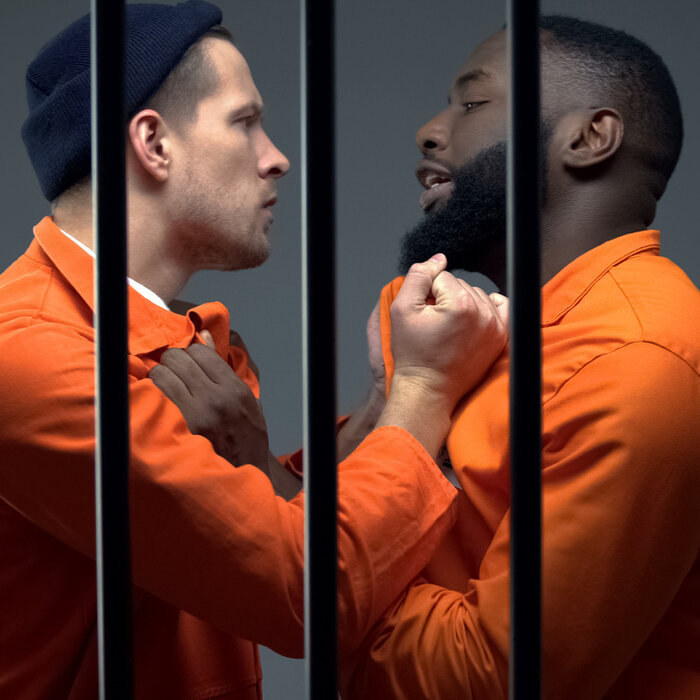“Research on Rhode Island guards in 1972 found that their potential for violence was slightly higher than that of inmates. The officer group actually had the potential for even more unexplained lashing out than did the inmates. Rather than being peacekeepers, the guards were as likely as inmates to engage in assaultive behavior.” “Black Power, White Blood,” by Johnny Spain and Lori Andrews
Here’s a little-known fact (a dirty federal-criminal-justice secret): Although the historic U.S. Supreme Court Brown v. Board of Education decision (1954) outlawed state-sponsored segregation, an exception still survives today: the federal penal colony run by the Bureau of Prisons. The racial progress that swept our country over the past several decades has had zero impact on the attitudes, thinking and world view of many federal prisoners and the rural, white C.O.s (correctional officers) who have power over us. There is a large number of neo-Nazi, White supremacist, hard-right-wing prison gangs and organizations in the feds, and the Jan. 6 insurrectionist trials have only strengthened them.
A few of those White supremacist organizations and gangs have built strong, lucrative alliances with Mexican networks who share an extreme prejudice against Black prisoners/groups. These merchants of racial bias and hate have literally divided the federal high-security penitentiaries and medium-security FCIs, to the point that White and Hispanic prisoners adamantly refuse (based upon the orders of their gangs) to be cellmates with Blacks. If they are foolishly bold enough to cross this racial line, they are certain to be savagely beaten by multiple assailants, stabbed and/or forced into protective custody.
Although there aren’t any “Whites Only” and “Colored Only” signs adorning prison entrances and exits, everything from TVs, to seating arrangements in the mess hall, to the rec tables in the housing units are claimed and controlled by race—White, Black, Native, Hispanic, etc.—or occasionally by specific gangs. And although Blacks welcome Whites who choose to ride with us, the reverse isn’t true. Once a White person chooses his allegiance upon moving to a prison, rules like these apply:
- Black prisoners can’t cook or dine with a White prisoner.
- Black prisoners can’t share contraband with Whites; they can’t get high, drink or even share a cigarette together.
- Whites absolutely cannot have a Black same-sex partner, if that’s their preference.
- White prisoners are not allowed to play on a Black sports team.
The BOP’s Machiavellian administrators are fully aware of this Jim Crow culture and uses it to manipulate the prison population and thus better manage/control us. Due to this concrete-steel-and-razor wire enclosure of cultural ignorance and racial intolerance, hate crimes are a daily occurrence—both prisoner-on-prisoner and White COs-on-Black-and-Brown prisoners.
Now that I’ve shared some context, allow me to share a specific example of administrative abuse of power—which could have triggered an institution-wide or even national race and gang war—along with a top-to-bottom cover-up.
Young Blood, Mr. 13 and the COs
I was thrown into the special housing unit (SHU, commonly known as solitary confinement) on April 27 for possession of contraband and fighting another prisoner (although the incident quickly dissipated). I was ultimately able to challenge the write-up for fighting and get it reduced to “horseplaying.” However, I was found guilty of possessing drugs and was punished with two weeks in in the SHU, 90 days without telephone privileges and six months without access to email.
While in the SHU, I was forced to share a cell with a brother I’ll call “Young Blood”—an intelligent, highly respectful, 30-year-old, biracial (African/Mexican American) dude from Atlanta who also is an active member of the Bloods gang. He had been taken off the compound because his security level had dropped from a high to a medium and BOP policy says that when that happens, he must be placed in the SHU until he can be moved.
At the same time Young Blood was sent into the SHU, a Mexican American prisoner I’ll call Mr. 13 came in to wait for a medical transfer. He is a soft-spoken, respectful, middle-aged guy who had just been diagnosed with cancer. However, he is also an active member of a Southern California gang called the South Siders. Knowing this, the lieutenant on duty, a Lt. Moore, decided to make the two share a cell—a sure recipe for disaster, since the Bloods and the South Siders are historic rivals. Mr. 13 made it very clear that strict, long-standing gang rules prohibited him from sharing a space with an African American; forcing him to do so would place him in mortal jeopardy. Lt. Moore then ordered his range officers to get the unit’s hand-held video camera so what happened next could be documented.
Once the two men were forced into the cell together, Lt. Moore ordered Young Blood to step forward and stick his hands through the door’s food-tray slot so his cuffs would be removed first—giving him the upper hand to seriously harm, if not kill, the now defenseless Mr. 13. Young Blood is literally in his prime, sculpted like an MMA [mixed martial arts] fighter. The two of us used to work out together in the SHU’s rec cages, banging out a thousand push-ups in under 45 minutes. Fortunately, Young Blood is proud of his Mexican heritage, confidant in his manhood and is not out to earn easy stripes by taking advantage of the vulnerable and weak, even if they happen to be on the opposing team. Therefore, he isn’t the type who is easily manipulated by his peers, much less the unprofessional, racist staff members of The Base, the covert, White supremacist organization that recruits members from law enforcement /correctional officers, the military and the government.
In contrast, Mr. 13 has long-standing relationships with racist White organizations like the Aryan Brotherhood and the Nazi Lowriders. He is deeply indoctrinated with a prejudice against all African Americans, particularly rival gang members. He felt he had no other choice but to attack Young Blood once his own handcuffs were unlocked. Mr. 13 lunged at Young Blood, throwing a lazy right cross, which the African American eluded without exerting much energy. Next, Mr. 13 attempted a front snap kick. Young Blood simply pivoted out of range, not bothering to counter with an offensive of his own.
Lt. Moore finally barked an order for the two to stop fighting and to back up to the food slot one at a time to be handcuffed. Both men complied without further problems. No injuries were documented by the medical staff and Young Blood and Mr. 13 were written up for disciplinary infractions. It was then that Young Blood was placed in the cell with me. Over time, we discussed everything that had happened. We were confident that the video recording would clear him of any wrongdoing; after all, he hadn’t thrown a punch. Even Mr. 13 agreed to testify on Young Blood’s behalf. And every morning, when Young Blood and I went outside to exercise in the SHU rec cages, the C.O.s escorting us talked in hushed tones with Young Blood, complaining how Lt. Moore knew he was wrong for forcing him and Mr. 13 into a cell together.
Nevertheless, when the time came for Young Blood to stand before a disciplinary hearing officer to argue his case, the officers reported that the video footage was missing—either intentionally destroyed or lost. And the same C.O.s who had complained about Lt. Moore wrote false reports, claiming they had witnessed the two prisoners pick a fight. Both Young Blood and Mr. 13 were found guilty and sentenced to 90 days of lost commissary privileges. Mr. 13 learned he had been mistakenly diagnosed with cancer and was shipped to another high-security penitentiary. Young Blood remains with me.
Some will recognize this incident as an abuse of authority; others will correctly add that it is a cover-up. Those of us on the inside know this is normal operations.




